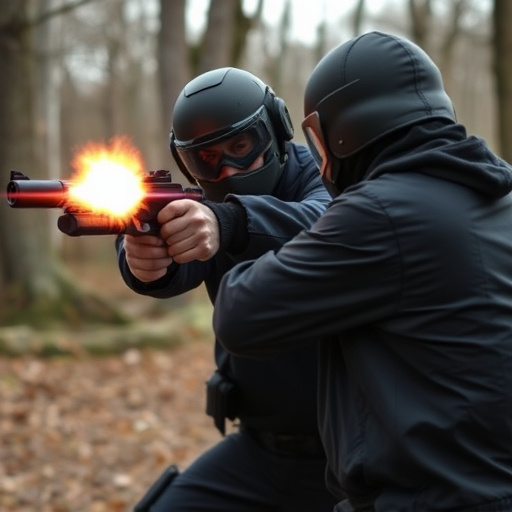Pink Stun Gun’s Contact Points: Enhancing Safety with Disable Pin Feature
The Pink Stun Gun with a Disable Pin Safety Feature combines style, safety, and functionality for ef…….
The Pink Stun Gun with a Disable Pin Safety Feature combines style, safety, and functionality for effective personal defense. Its unique design leverages the pink color's deterrent effect while featuring a safety mechanism that requires a disable pin to activate, preventing accidental discharge. Strategically placed contact points ensure maximum shock with minimal risk, making it a reliable tool for self-defense in unexpected situations.
“Discover the surprising power of stun guns as a personal safety tool, especially the innovative design of the Pink Stun Gun. This device goes beyond conventional methods with its unique features. In this article, we explore the science behind stun guns and delve into the significance of contact points in their effectiveness.
Furthermore, we’ll uncover how the disable pin safety feature enhances user control, ensuring a powerful yet secure self-defense mechanism. Get ready to understand why the Pink Stun Gun with its disable pin safety feature is a game-changer for personal safety.”
- Understanding Stun Guns: How Do They Work?
- The Pink Stun Gun: A Unique Approach to Personal Safety
- Contact Points and Their Role in Stun Gun Effectiveness
- Disable Pin Safety Feature: Enhancing User Control and Safety
Understanding Stun Guns: How Do They Work?

Stun guns, also known as electroshock weapons, are designed to incapacitate a target by delivering an electric current that disrupts their muscular control. Unlike traditional firearms, stun guns do not fire projectiles but instead use electrical impulses to create a temporary loss of muscle coordination. This non-lethal force makes them a popular choice for personal defense, especially for individuals seeking a less destructive alternative to conventional weapons.
One notable example is the pink stun gun with a disable pin safety feature. This unique design combines aesthetic appeal with enhanced safety measures. The pink color often associated with self-defense products serves as a reminder of the weapon’s purpose while also potentially deterring aggressors. The disable pin safety feature adds an extra layer of protection, ensuring that the device can only be activated when needed, further emphasizing the stun gun’s control and user-friendliness.
The Pink Stun Gun: A Unique Approach to Personal Safety

The Pink Stun Gun stands out in the personal safety device market, offering a unique blend of style and functionality. It’s more than just an eye-catching accessory; this stun gun is designed with modern needs in mind, incorporating advanced features for enhanced protection. One of its standout aspects is the disable pin safety feature, ensuring accidental activation is virtually impossible. This innovative mechanism allows users to carry the stun gun with peace of mind, knowing it will only deploy when intended.
With a sleek pink color, it serves as more than just a deterrent; it’s a bold statement against potential threats. The device is tailored for those seeking an effective yet discreet self-defense solution, suitable for various situations where personal safety is paramount. Its compact design and simple operation make it easily portable, empowering individuals to take control in unexpected scenarios.
Contact Points and Their Role in Stun Gun Effectiveness

Contact points are a critical aspect of a stun gun’s design, playing a pivotal role in its overall effectiveness. These points, strategically placed on the device, deliver an electric current to disrupt the opponent’s nervous system, causing temporary incapacitation. In the case of a pink stun gun with a disable pin safety feature, these contact points are engineered for both optimal energy transfer and user safety. The design ensures that when activated, the stun gun makes firm and precise contact with the target, maximizing the electric shock while minimizing the risk of accidental activation or harm to bystanders.
The arrangement and quality of contact points significantly influence the weapon’s performance. Well-designed contact points maintain a consistent and strong connection, allowing for a powerful discharge that disrupts muscle control and coordination. This feature is particularly valuable in self-defense scenarios where swift and reliable incapacitation is essential. Moreover, the disable pin safety mechanism adds an extra layer of control, ensuring users can deploy the stun gun with confidence, knowing they have a secure and targeted means of protection.
Disable Pin Safety Feature: Enhancing User Control and Safety

The effectiveness of a stun gun isn’t just measured by its jolting power; user control and safety are equally important aspects. One unique advantage of certain models, like the pink stun gun with a disable pin safety feature, is the ability to enhance user control and reduce accidental discharges. This safety feature allows users to quickly deactivate the device by inserting a pin, ensuring that it’s under constant user supervision. By eliminating the risk of unintentional activation, this design promotes safer handling, making it ideal for individuals seeking both powerful protection and peace of mind.
This disable pin mechanism offers an extra layer of security without compromising ease of use. Users can confidently deploy the stun gun when needed, knowing that a simple pin insertion prevents accidental shocks. This feature is particularly appealing to those who value control and safety, providing them with a reliable personal defense tool that’s easy to manage in high-stress situations.
In conclusion, stun guns have evolved from their traditional image, with innovations like the Pink Stun Gun offering enhanced personal safety. Understanding the science behind contact points and incorporating features like disable pin safety can significantly improve effectiveness. For those seeking a unique and powerful self-defense tool, the Pink Stun Gun with its disable pin safety feature stands out as a modern solution, combining efficacy and user control in a compact design.


